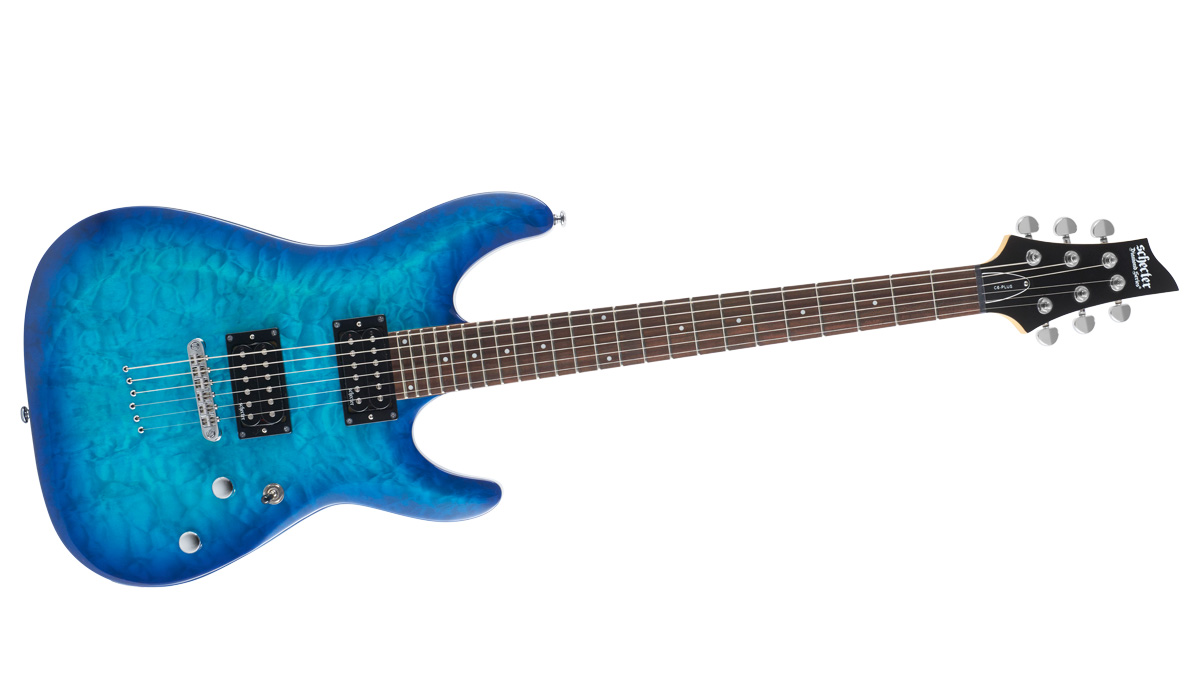MusicRadar Verdict
So what if gigging the C-6 Plus in a dingy bar might feel like wearing a ruff and pearl earring to order a McDonald's, Schecter has put together a guitar of real substance.
Pros
- +
Bags of fun. Cheap!
Cons
- -
That dull name!
MusicRadar's got your back
With its aquamarine quilted-maple finish, the Schecter C-6 Plus might look a little extravagant - but that doesn't mean it's not for the people.
Here we have a mid-priced S-style electric that's built for action, for an honest day's work, for by-the-metronome proletariat stamina exercises through the modes of the major scale.
Besides, the C-6 Plus's looks are skin deep. The 'quilted maple' is actually just an image that's been printed on to a basswood body, maintaining the ostentatious illusion of class when, ultimately, the real story is that the C-6 Plus is one of the most fun, most fuss-free, and most sonically persuasive electrics that can be picked up for less than £300.
Contrasting that azure, Great Barrier Reef finish is a nicotine-yellow maple neck, bolted onto the body and cut to a soft-C that is svelte enough for speed, yet offers impressive comfort, too.
Your favourite Megadeth track might suddenly feel achievable.
In neck and bridge positions there are two Schecter Diamond humbuckers, each selected by a three-way switch, with master volume and tone knobs to help you dial in your sound. It's that easy.
With a tidy string-though tune-o-matic bridge offering quick setups and a really solid core, there's a pragmatism - no floating vibrato or coil-tap to divert your attention - that's designed to keep you playing longer. The C-6 Plus can handle a succession of a Herculean string bends and still remain solidly in tune.
There's really no mystery to the C-6 Plus, except maybe why Schecter doesn't think it's worthy of a catchier name. It is certainly worth your attention, and should get it from anyone whose game is rock and metal.
As with most of Schecter's guitars, the C-6 Plus will sit most comfortably with those looking to play fast and hard. Yeah, sure, all guitars are built to play, but that is not always the result at lower price points, but the C-6 Plus is exceptionally playable. No matter your ability or experience, it flatters you, and that is always a bonus.
When, however, the target demographic is the intermediate player who practises hard for incremental results, that flattery means everything, and it makes for more confident guitarists. With extra jumbo frets rewarding busy lead playing, those difficult transcriptions of your favourite Megadeth track might suddenly feel achievable.
In high-gain scenarios, the C-6 is tight, aggressive, with lots of harmonic expression. That's true of either pickup. While the neck pickup disciplines your leads with a more rounded tone, it doesn't rinse the C-6 of its personality - its bark. It cleans up nicely, too, excelling in growly bluesy tones with that edge of danger and promise of more overdrive; that's where the C-6 Plus becomes most organic, most alive.
Jonathan Horsley has been writing about guitars and guitar culture since 2005, playing them since 1990, and regularly contributes to MusicRadar, Total Guitar and Guitar World. He uses Jazz III nylon picks, 10s during the week, 9s at the weekend, and shamefully still struggles with rhythm figure one of Van Halen’s Panama.
“A synthesizer that is both easy to use and fun to play whilst maintaining a decent degree of programming depth and flexibility”: PWM Mantis review
“I feel like that song had everything we needed to come back with”: Bring Me The Horizon’s Lee Malia on Shadow Moses, its riff and the secrets behind its tone, and why it was the right anthem at the right time
“I said, ‘Are we sure we can write a song about death?’”: The story of Mike + The Mechanics' classic No.1 The Living Years











